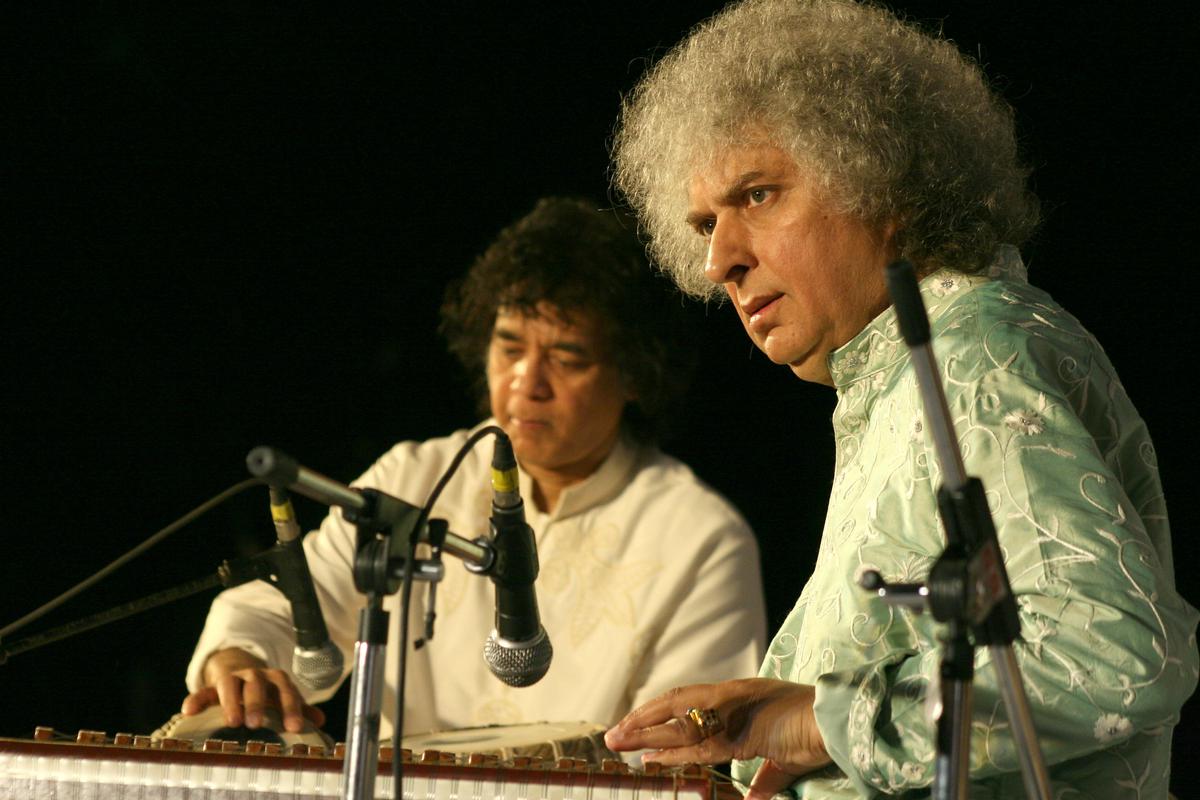Pt. Shivkumar Sharma, who passed away recently, will always be remembered for making a folk instrument an integral part of the classical world
Pt. Shivkumar Sharma, who passed away recently, will always be remembered for making a folk instrument an integral part of the classical world
Nobody else could have been a better ambassador of the santoor than the Jammu-born Pt. Shivkumar Sharma. Raised in the lap of the Himalayas, he captured the melody of the mountain air and serenity of the snowcapped peaks in the 100-stringed hammered dulcimer. Not surprisingly, Pahadi was among his favourite raags and a staple at his concerts. It assumed a distinct beauty on the santoor, evolving in a quaint, unhurried manner. His 1993 album, ‘Music of the Mountains’, showed how the santoor could recreate the haunting sounds and magical colours of the landscape.
No conversation with the soft-spoken and unassuming maestro was complete without him sharing his memories of the years spent in the khubsurat wadiyan (beautiful valley). Though he shifted to Mumbai to be part of the Hindustani music scenario, he always said he had left behind a part of him in Jammu.
“ Mera sangeet us mahaul, taalim, tehzeeb ka nichod hai (my music is the essence of that ambience, training and culture),” he told me during an interview before a performance in Chennai in 2015. Despite a sophisticated presentation style, Pt. Shivkumar’s music remained rooted in old-world aesthetics.
He chose to be a santoor artiste at the instance of his father Uma Dutt Sharma, a trained vocalist of the Benaras gharana, who could also play the tabla and santoor. Though he wasn’t keen to learn the instrument, Pt. Shivkumar soon became its most dynamic voice, a catalyst, who transformed the unknown folk instrument used in sufiana mausiqi (sufi music) into a popular and complete classical instrument. He worked tirelessly to modify its trapezoidal shape, the number of strings, material of the stick and strings, and played it by placing it on the lap instead of on a stand. He also improved its range, playing technique and tonal quality and eventually became a sought-after soloist.
“You can say I nurtured it in my lap very much like how a mother tends to a baby,” he smiled running his hand gently over the strings during the interview. When I set out to fulfil my father’s dream and vision, purists and critics tried to put me down. They advised me to go back to vocal music or to playing the tabla, in which I am well-versed too. The more they dissuaded me, the more I became determined to go ahead. And today, here I am.”
Pt. Shiv Kumar Sharma and Pt. Hariprasad Chaurasia performing at Bharat Bhawan in Bhopal on in 2014.
| Photo Credit: PTI
In his hands, the santoor also received global acclaim, and he performed at major international festivals. As much as he was a stickler for tradition, Pt. Shivkumar was open-minded enough to constantly push the boundaries of classical music to widen its appeal. Says his senior disciple and santoor exponent, Satish Vyas, “His biggest achievement was turning non-classical listeners into rasikas. He would say, ‘Whether you follow the repertoire or seek cross-genre collaborations, maintain the dignity of your art. It’s our responsibility to create a dedicated shrota (listeners) for it’.”
Satish feels indebted to his guru for helping him make this instrument his life’s calling. “At 13, when I first heard him play the santoor, I knew I wanted to be his disciple. The most endearing teacher, he would repeat every single nuance and note with patience. Sometimes the classes would go on for three to four hours. At the end of which, you would still find him relaxed and smiling. He would never send his sishyas back without feeding them.”
Pt. Shivkumar was passionate about making the santoor a part of diverse music settings. His austere methods didn’t cramp his free-flowing imagination. “My belief in the santoor’s reach and potential are so strong that I am never afraid to explore. I know it will never let me down. Everytime I pick it up, I view the world with renewed confidence,” he had said when asked about composing for films.
In the 1960s, he joined hands with friend and collaborator Pt. Hariprasad Chaurasia, releasing albums under the banner, ‘Shiv-Hari’. They also created melodious songs at a time when loud and racy western-inspired tunes defined film music.
When director Yash Chopra roped them as music directors for Silsila, the decision shocked both the film and classical worlds. But the two masters proved that their music is not limited by genres and labels.
During an interview in 2016, Pt. Hariprasad Chaurasia, described this long musical partnership as not just the coming together of two very different instruments, but the meeting of two thinking minds and simple souls. “Acche guru ka milna aur sangeet mein acche saath-sangat ka hona, maa Saraswati ki den hain (to get a good guru and collaborator is the blessing of Saraswati).”

Pt. Shiv Kumar Sharma and Ustad Zakir Hussain performing in New Delhi on February 19, 2008.
| Photo Credit: SHIV KUMAR PUSHPAKAR
Pt. Shivkumar was often accompanied at concerts on the tabla by Ustad Zakir Hussain, who, though known for his showmanship, would prefer to be unobstrusive and subdued with Panditji. “When you share the stage with musicians like him, you have to keep in mind their pioneering efforts to take music to such great heights,” he had said after a performance in Chennai in 2010.
Son and disciple Rahul Sharma has been carrying forward the legacy, but was always encouraged by Pt. Shivkumar to find his own space in the world of music and search for newer expressions quite like how he had done.






